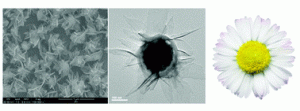It is the quest of many a materials scientist to form core-shell nanostructures by self-assembly, in order to generate materials with unique structures and functions. In this area, hierarchical nanoarchitectures assembled from nanoscale units have recently stimulated tremendous interest because these superstructures might avoid aggregation and maintain high specific surface areas. In addition, magnetic materials have received considerable interest, due to their ability to selectively capture target objects from complex mixtures.
Ken Cham-Fai Leung and colleagues – based in Hong Kong and Hefei, China – have reported a facile synthesis of monodispersed microparticles composed of superparamagnetic Fe3O4 cores, a SiO2 shell and a hierarchical g-AlOOH periphery with Au nanoparticles, obtaining nanoflower structures resembling daisies. As proof of principle for their use as selective protein capturing agents, these nanoflowers were applied as absorbents to successfully remove bovine serum albumin from bovine blood.
To find out more download the ChemComm communication, which is free to access until 15th March 2011.
Start a discussion about this research by leaving comments below.











